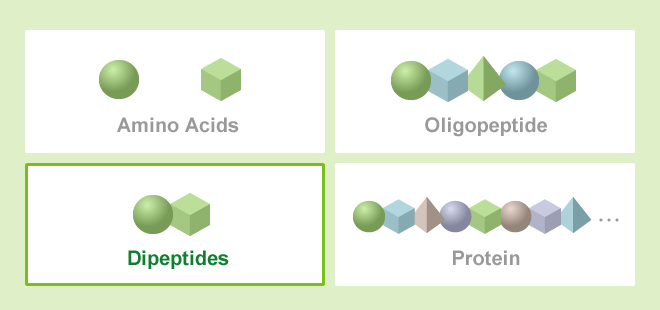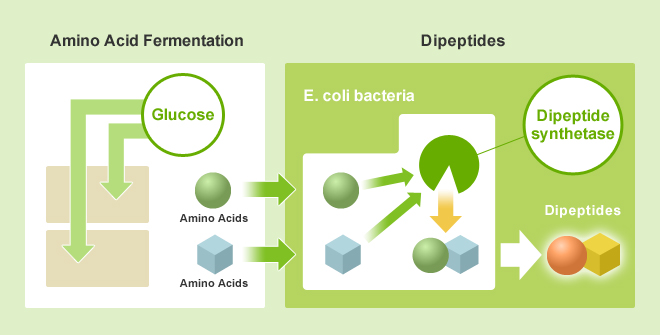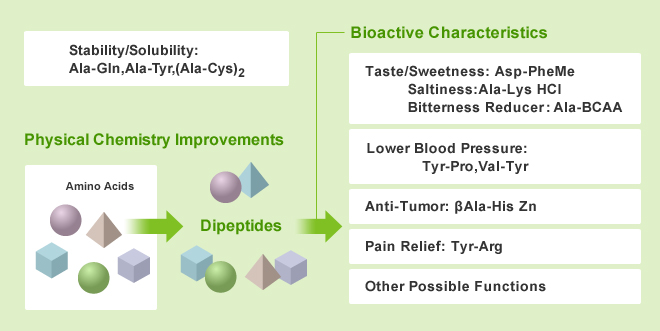KYOWA HAKKO BIO has established a novel industrial process for dipeptide manufacturing. Since dipeptides have characteristics that cannot be found in the corresponding amino acids, further exploration is anticipated.
What is a dipeptide?

Peptides are short polymers formed by the linking of amino acids. The main difference between peptides and polypeptides/protein is that peptides are short and polypeptides/proteins are long. A dipeptide is a short chain of two amino acids.
Discovery of an enzyme that directly links two free amino acids
KYOWA HAKKO BIO has discovered an enzyme from Bacillus subtilis that allows two free amino acids to be directly linked. This enzyme reacts with a wide variety of L-amino acids and can synthesize several kinds of dipeptides.
Novel industrial process established for dipeptide manufacturing

While there have been several ways to produce dipeptides, most are complicated and costly. By combining our traditional amino acid fermentation technology with a dipeptide-forming enzyme that directly links amino acids, we created a new, cost-effective manufacturing process. Moreover, the characteristics of our enzyme allow us to expand the variety of dipeptides that can be manufactured.
The first example of our dipeptide production process is for Alanylglutamine (AlaGln). L-Glutamine (Gln), despite its nutritional importance, is difficult to use as a component of solutions, due to its instability when exposed to heat or acids. The Gln-containing dipeptide, AlaGln, overcomes these drawbacks and is expected to be used in pharmaceutical or nutritional fields. It is branded as Sustamine® and is being used in several consumer products.
Dipeptide World

The unique physical characteristics of dipeptides allow them to be widely applicable compared to their corresponding amino acids. In addition to these physico-chemical features, certain kinds of dipeptides revealed unique physiological functions. KYOWA HAKKO BIO expects to expand the applications of dipeptides by supplying them at a low cost through its manufacturing process.
KYOWA HAKKO BIO regards dipeptides as next-generation amino acids that surpasses its own limitations and intends to collaborate with researchers and companies to explore the "dipeptide world".
Research papers
- K. Tabata K, H. Ikeda, S. Hashimoto, ywfE in Bacillus subtilis codes for a novel enzyme, L-amino acid ligase. J. Bacteriol., 87(15), 5195-202 (2005)
- K. Tabata, S. Hashimoto, Fermentative production of L-alanyl-L-glutamine by a metabolically engineered Escherichia coli strain expressing L-amino acid alpha-ligase. Appl. Environ. Microbiol., 73(20), 6378-85 (2007)
- M. Yagasaki, S. Hashimoto, Synthesis and Application of Dipeptides; Current Status and Perspectives. Appl. Microbiol. Biotechnol., 81, 13-22 (2008)
- M. Hayashi, K. Tabata, M. Yagasaki, Y. Yonetani, Effect of multidrug-efflux transporter genes on dipeptide resistance and overproduction in Escherichia coli. FEMS Microbiol. Lett., 304, 12-19 (2010)
- Y. Shomura, E. Hinokuchi, H. Ikeda, A. Senoo, Y. Takahashi, J. Saito, H. Komori, N. Shibata, Y. Yonetani, Y. Higuchi. Structural and enzymatic characterization of BacD, an L-amino acid dipeptide ligase from Bacillus subtilis. Protein Sci., 21, 707-16 (2012)

